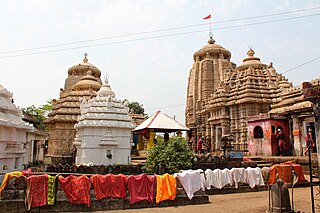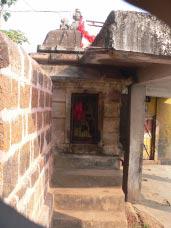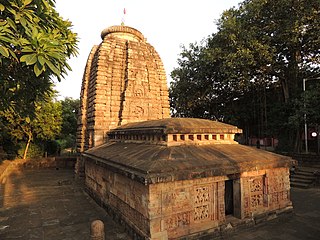
Mukteshwara Temple is a 10th-century Hindu temple dedicated to Shiva located in Bhubaneswar, Odisha, India. The temple dates back to 950–975 CE and is a monument of importance in the study of the development of Hindu temples in Odisha. The stylistic development the Mukteswara marks the culmination of all earlier developments, and initiates a period of experiment which continues for an entire century, as seen in such temples as the Rajarani Temple and Lingaraj temple, both located in Bhubaneswar. It is one of the prominent tourist attractions of the city.
Tourism in Odisha is one of the main contributors to the Economy of Odisha, India, with a 500 km (310 mi) long coastline, mountains, lakes, natural biodiversity and rivers. Odisha is one of the major tourism sectors of India, with various tourists' attractions, ranging from wildlife reserves, beaches, temples, monuments, the arts and festivals. Other than wildlife reserves, beaches, temples, monuments, the arts and festivals, the Odisha Tourism Development Corporation, a Public Sector Undertaking of Government of Odisha, is also developing tourism sector of Odisha and India.

The Kapilesvara temple is a Hindu temple dedicated to Shiva located in the south western outskirt of the village Kapilesvara, Old Town, Bhubaneswar, Odisha, India. It is located at the end of Kapilesvara road leading from Lingaraj temple to Kapilesvara Village. The presiding deity is a Siva-lingam at the center of a circular yonipitha inside the sanctum. It is a living temple, facing towards east and maintained by Kapilesvara Temple Trust Board. The temple is situated within the precinct along with 33 other monuments. The precinct is located on the northern embankment of Manikarnika tank over an area of 44.00 square metres.

Anshuman temple is a 10th-century temple in Bhubaneswar in the state of Odisha, India. It is on the southwestern embankment of Bindusagar tank in Badu Sahi, Old town.

Champakeswara Shiva Temple is located Ambika Sahi in the Old Town area of Bhubaneswar in Odisha, India. It is 157 metres west of Parasuramesvara on the right side of the Kotitirthesvara lane leading to Bindu sagara. It is a laterite temple. Local people believe that the enshrined Siva lingam is patalaphuta and the precinct is the abode of nagas after whom the deity is named as Champakesvara. The local people also believe that the temple precinct which is a den for the snakes do not harm any body.

Chintamaniswar Shiva Temple is a Hindu temple dedicated to Lord Shiva in Bhubaneswar, the capital of Odisha, India. It is at the end of the Chintamaniswar road branching from Cuttack-Puri road near the Old Station Bazar. The temple faces west and the enshrined deity is a Siva lingam with a yonipitha.
Sanisvara Siva Temple is a Mandir situated at Gosagaresvara Precinct southern of Paradaresvara Siva Temple, Orissa, India. The temple is facing towards the east, enshrined deity is a circular Yoni Pitha at the center of a 1.00 square meter sanctum.

Kukutesvara Tank is associated with the Kukutesvara Siva temple of Bhubaneswar.
Manikarnika tank is located beyond the southern compound wall of the Kapilesvara temple precinct, in the outskirt of the village Kapilesvara, Old Town, Bhubaneswar. It is now under the care and maintenance of Kapilesvara Trust Board. The tank is enclosed within a masonry embankment made of both dressed sandstone and laterite blocks.

Kotitirtha Tank is a sacred tank, used as a ritual bath in Hinduism, located near the Kotitirthesvara temple in the Kotitirthesvara lane, Old Town, Bhubaneswar, Odisha, India. It is now under the care and maintenance of the Kotitrithesvara Thakura Development Committee. The tank is enclosed within a masonry embankment made of dressed Laterite blocks.
Bhrukuteswar Shiva Temple is situated in Yamesvara Patna, Old Town, Bhubaneswar in Odisha, India. It is a single structure pidha deul without any frontal porch. According to the local people this temple was built by the Kesaris (Somavamsis).
The Dalmiya Dharmasala is a three-storey building which serves as a temporary stay for visitors and pilgrims. The foundation stone dates the dharmasala back to 1920 A.D. and was commissioned by Rai Bahadur Sedmull Dalmia under the name Rai Bahadur Sedmull Dalmia Dharmasala. At present, the dharmasala is maintained by a Broad of Trustees under the care of Gunanidhi Mohapatra. Situated in the Tala Bazar Chowk across the road in the eastern embankment of Bindusagar Tank, Old Town, Bhubaneswar, this private property is surrounded by a paddy field in the east, the Bindusagar tank in the west across the road at a distance of 5.00 metres, private residential buildings in the north and the Doodwawalla Dharmasala in the south. The Dharmasala can be approached on the left side of the Talabazar road branching from Kedara-Gouri Chowk to the Lingaraja temple.
Patalesvara Siva Temple – II is a Shiva temple located in Bhubaneswar, Orissa, India. This temple dates back to the 10th/11th century and is partly buried and broken.
The Vishnu Temple, Bhubaneswar is a Hindu temple dedicated to Lord Vishnu situated on the eastern embankment of Bindu Sagar at Talabazar, on the right side of the Talabazar road leading from Lingaraj temple to Kedara-Gouri lane in Bhubaneswar, the capital of Odisha, India. The temple faces west and the Sanctum is used for storage purposes. The sculptural embellishment on the outer wall and the parsavadevatas in raha niche suggests that the temple was originally dedicated to Vishnu.

Suka Temple is an abandoned and unused temple in Bhubaneswar, the capital of Odisha, India. The temple is devoted to saptaratha and the presence of female counterparts of the dikpalas in the upara jangha. This was built in the matured phase of temple building tradition of Odisha.

Bhima Kunda (tank) is located beyond the western compound wall of the Bhimesvara Temple precinct, in Kapila Prasad, Old Town, Bhubaneswar. It is now under the care and maintenance of Bhimesvara Temple Development Committee. The tank was excavated by cutting through the laterite bed rock. The embankment is made of dressed laterite blocks.
Chakresvara Tank is behind the Chakresvara temple which is in the Hatiasuni lane, Rajarani colony, Bhubaneswar, Odisha, India. One can approach the site at the end of the Hatiasuni lane branching from tankapani road. It is situated to the south west of Rajarani temple. The tank is surrounded by Chakresvara temple in east, residential building in north, and pasture land on other two sides.
Chakresvara Shiva temple is a living Hindu temple built in 10-11 AD dedicated to Lord Shiva at Hatiasuni lane, Rajarani Colony, Bhubaneswar of Odisha, India. The deity, lingam, is in a circular yonipitha inside the sanctum. The temple is surrounded by private residential buildings on its eastern and northern side and chakresvara tank in the west. It is of great significance as rituals like Shivaratri, Diwali, and Sankranti are observed here. Also this temple serves as a purpose of a sacred place for 'Thread Ceremony, Rudrabhiseka, Chandrabhiseka.'

Ekamra Kshetra or the temple city of Bhubaneswar is a series of ancient sandstone temples, heritage ponds and water tanks, its wealth of monuments is testament to an ancient continuous architectural and historical heritage covering over 2,000 years from the 3rd century BC to the 15th century AD. It has been listed as a tentative site in UNESCO World Heritage list.









